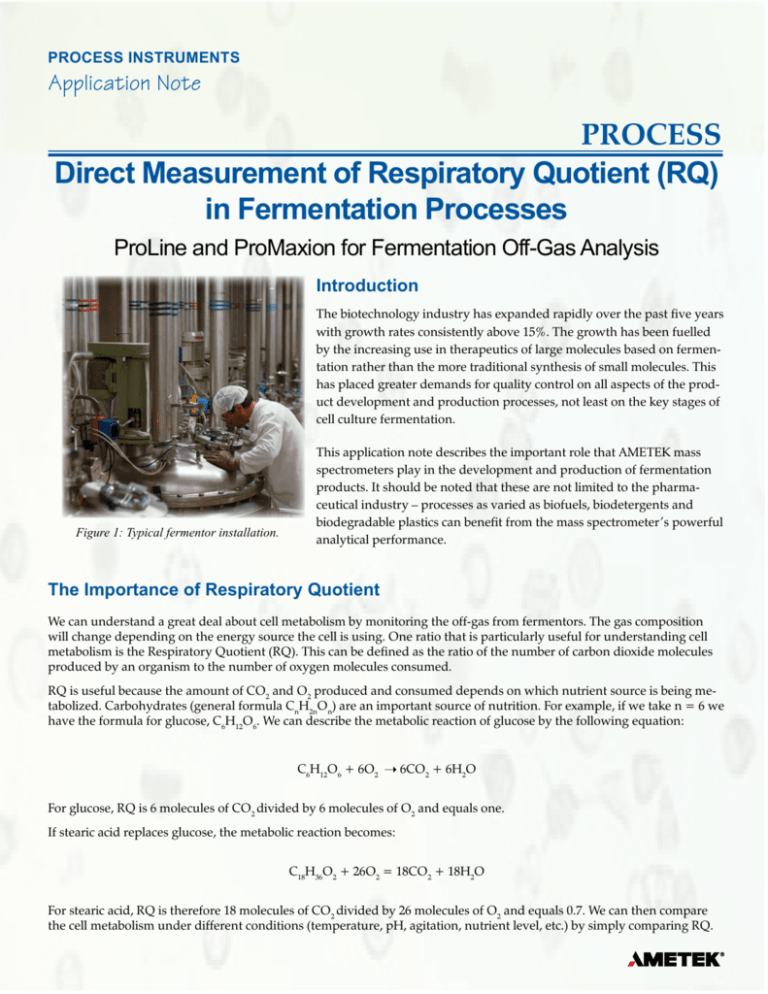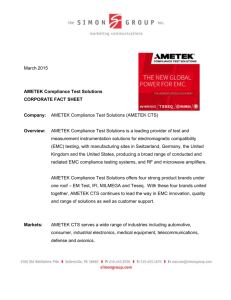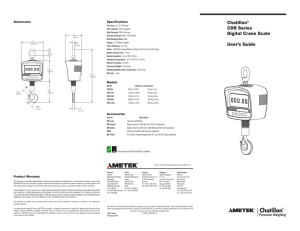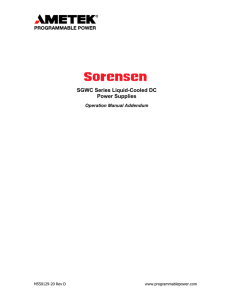
PROCESS INSTRUMENTS
Application Note
PROCESS
Direct Measurement of Respiratory Quotient (RQ)
in Fermentation Processes
ProLine and ProMaxion for Fermentation Off-Gas Analysis
Introduction
The biotechnology industry has expanded rapidly over the past five years
with growth rates consistently above 15%. The growth has been fuelled
by the increasing use in therapeutics of large molecules based on fermentation rather than the more traditional synthesis of small molecules. This
has placed greater demands for quality control on all aspects of the product development and production processes, not least on the key stages of
cell culture fermentation.
Figure 1: Typical fermentor installation.
This application note describes the important role that AMETEK mass
spectrometers play in the development and production of fermentation
products. It should be noted that these are not limited to the pharmaceutical industry – processes as varied as biofuels, biodetergents and
biodegradable plastics can benefit from the mass spectrometer’s powerful
analytical performance.
The Importance of Respiratory Quotient
We can understand a great deal about cell metabolism by monitoring the off-gas from fermentors. The gas composition
will change depending on the energy source the cell is using. One ratio that is particularly useful for understanding cell
metabolism is the Respiratory Quotient (RQ). This can be defined as the ratio of the number of carbon dioxide molecules
produced by an organism to the number of oxygen molecules consumed.
RQ is useful because the amount of CO2 and O2 produced and consumed depends on which nutrient source is being metabolized. Carbohydrates (general formula CnH2nOn) are an important source of nutrition. For example, if we take n = 6 we
have the formula for glucose, C6H12O6. We can describe the metabolic reaction of glucose by the following equation:
C6H12O6 + 6O2 6CO2 + 6H2O
For glucose, RQ is 6 molecules of CO2 divided by 6 molecules of O2 and equals one.
If stearic acid replaces glucose, the metabolic reaction becomes:
C18H36O2 + 26O2 = 18CO2 + 18H2O
For stearic acid, RQ is therefore 18 molecules of CO2 divided by 26 molecules of O2 and equals 0.7. We can then compare
the cell metabolism under different conditions (temperature, pH, agitation, nutrient level, etc.) by simply comparing RQ.
We can convert number of molecules to volume by dividing by Avogadro’s number (1019 molecules / cm3 for standard temperature and pressure):
RQ
=
CO2 molecules
O2 molecules
x
1019
=
10 19
Vc
Vo
Since the conversion factor appears in numerator and denominator, we can simply use the
volume of carbon dioxide released (Vc) divided by the volume of oxygen consumed (Vo) as a
substitute for the number of molecules.
Historically dedicated gas analyzers—paramagnetic for oxygen, non-dispersive infra-red
(NDIR) for carbon dioxide—have measured the oxygen and carbon dioxide in the air going into
the fermentor and the off-gas exiting the fermentor. These analyzers measure concentration in
volume percent or volume ppm, so the RQ calculation becomes:
RQ
=
(%vol of CO2out x FLOWout) – (%vol CO2in x FLOWin)
(%vol of O2in x FLOWin) – (%vol O2out x FLOWout)
=
CER
OUR
CER is defined as the Carbon Dioxide Evolution Rate, OUR as the Oxygen Uptake Rate.
The measurement of flowrates introduces errors that limit the accuracy of the RQ measurement:
mass flowmeters are typically only accurate to ±5%. In addition, the relatively slow analysis
speed of paramagnetic and NDIR analyzers limits the number of fermentors that can be monitored with one set of discrete analyzers. This can lead to further errors in RQ measurement if
one set of analyzers is used to measure air feed and another to measure off-gas.
Benefits of Mass Spectrometry
Analysis Speed
AMETEK quadrupole mass spectrometers can measure and report the four major air gas components (nitrogen, oxygen, argon and carbon dioxide) in as little as two seconds. Therefore,
multiple reactors can be monitored with a single instrument. Even allowing for stream switching and settling times, the analyzer can measure the RQ within 10 to 20 seconds per fermentor.
Air feeds and off gases are monitored with one instrument allowing concentration data to be
compared and catalogued easily and more accurately.
Wide Dynamic Range
Mass spectrometry’s wide dynamic range allows accurate measurement of gas species from
ppm to percentage levels. Other techniques require multi-point calibrations to cover the component ranges that are found in the analysis. In some cases they even require different analyzers such as when measuring around 300ppm carbon dioxide in air feed, or percentage levels of
carbon dioxide in the off-gas.
Accurate RQ Calculation without Flow Measurement
The mass spectrometer not only measures the respiratory gases but also nitrogen and argon. We
can use this to eliminate the flow measurement. For most standard fermentations, nitrogen is
neither consumed nor produced by the process; it follows that:Therefore:
(%vol of N2in x FLOWin) = (%vol N2out x FLOWout)
FLOWout
=
%vol of N2in x FLOWin
%vol N2out
We can now calculate CER and OUR by:CER = {CO2out x (N2in x FLOWin)/N2out } – (CO2in x FLOWin)
OUR = (O2in x FLOWin) – {O2out x (N2in x FLOWin)/N2out }
And RQ becomes (now without flow):
{CO2out x (N2in / N2out )} - CO2in
O2in – {O2out x (N2in / N2out )}
Note that although the RQ calculated using nitrogen concentration correction is exactly the same value as
that calculated using the classical flow correction method 1, the numerator and denominator are not CER
and OUR. They may more correctly be referred to as CDI and OXR, carbon dioxide increase and oxygen
reduction. Nitrogen
Oxygen
OXR
RQ
0.047
N2In/N2Out
CDI
20.491
CO2
Air Inlet
78.595
Fermentor 1
78.700
20.193
0.255
0.999
0.207
0.326
0.637
Fermentor 2
78.785
20.179
0.189
0.998
0.141
0.361
0.391
Fermentor 3
78.698
20.178
0.271
0.999
0.224
0.340
0.660
Fermentor 4
78.776
20.178
0.194
0.998
0.146
0.360
0.407
1.000
TABLE 1: Example of RQ calculation using the nitrogen concentration correction (actual process MS field data).
If the fermentation does actually consume or produce nitrogen (for example, nitrogen fixing micro-organisms), then
argon volume concentrations in and out can be used to make the flow correction.
Benefits of Ametek Process Mass Spectrometers
Choice of Analyzer Package
AMETEK offers two analyzers for fermentation off-gas analysis.
• PROLINE Benchtop configuration with up to 16 sample points, for General
Purpose locations.
•
PROMAXION Process configuration with up to 32 sample points for harsh
environment locations.
Both systems use the same AMETEK quadrupole analyzer. With
more than 6,000 units installed worldwide, AMETEK mass spectrometers provide performance, reliability and ease of use. The AMETEK
product range assists in the scale-up process, from laboratories and
pilot plants using ProLine to full productions facilities using ProMaxion—the results will correlate from one analyzer to the other.
Figure 2. System switching between several fermentors and common air inlet.
Powerful, Flexible Software
AMETEK’s Process 2000 software provides automatic control
of sample switching and calibration (Figure 2). Analog and
histogram scans help to fingerprint fermentations, and trend
displays monitor concentrations. Air gases, as well as volatiles
such as alcohols, can be monitored down to ppm levels. Autotune algorithms ensure the analyzer is always optimized and
the software’s powerful calculation facility makes it easy to set
up the RQ calculations. Figure 3 shows an example of how this
can be done.
Process 2000 supports industry standard communication protocols like Modbus and OPC for reliable transfer of analytical
data to process control systems. And if OUR and CER calculations need to be handled in Process 2000, optional analog input
hardware can take flow signals into the OUR/CER calculations.
Figure 3. Process 2000 calculation capability.
Summary
AMETEK’s ProLine and ProMaxion mass spectrometers provide multipoint, multicomponent analysis of fermentation offgas. They measure not only respiratory gases, but nitrogen, argon and volatiles as well.
The accurate measurement of nitrogen (or argon) means the systems can calculate and report Respiratory Quotient
information with much greater accuracy than traditional methods based on flow measurement. This information can be
transferred to process control systems by analog or serial communication protocols.
Optional 21CFR Part 11 Process Software complies with FDA requirements for data security and validation.
As with all AMETEK process analyzers, ProLine and ProMaxion are supported by our international service organization.
1.
P.C. van der Aar, A.H. Stouthamer and H.W. van Verseveld, Possible misconceptions about O2 consumption and CO2 production
measurements in stirred microbial cultures, Journal of Microbiological Methods 9, (1989) 281-286.
One of a family of innovative process analyzer solutions from AMETEK Process Instruments. Specifications subject to change without notice.
USA - Pennsylvania
150 Freeport Road
Pittsburgh, PA 15238
Ph. 412-828-9040
Fax 412-826-0399
CANADA
2876 Sunridge Way N.E
Calgary, AB T1Y 7H9
Ph. 403-235-8400
Fax 403-248-3550
MANUFACTURING
LOCATIONS
USA - Delaware
455 Corporate Blvd.
Newark, DE 19702
Ph. 302-456-4400
Fax 302-456-4444
SUPPORT LOCATIONS
www.ametekpi.com
USA - Oklahoma
2001 N. Indianwood Ave.
Broken Arrow, OK 74012
Ph. 918-250-7200
Fax 918-459-0165
© 2006, by AMETEK, Inc. All rights reserved.
RQ App (09/06)
USA Texas
CHINA Beijing
Ph. 86 10 85262111 Chengdu Ph. 86 28 86758111
Shanghai Ph. 86 21 64268111
Ph. 281-463-2820
Fax 281-463-2701
Fax 86 10 8526 2141
Fax 86 28 8675 8141
Fax 86 21 6426 7818
FRANCE
Ph. 33 1 30 68 89 00
Fax 33 1 30 68 89 99
GERMANY
Ph. 49 21 59 91 36 0
Fax 49 21 59 91 3680
MIDDLE EAST Dubai
Ph. 971-4-881 2052
Fax 971-4-881 2053
SINGAPORE
Ph. 65-6484-2388
Fax 65-6481-6588












